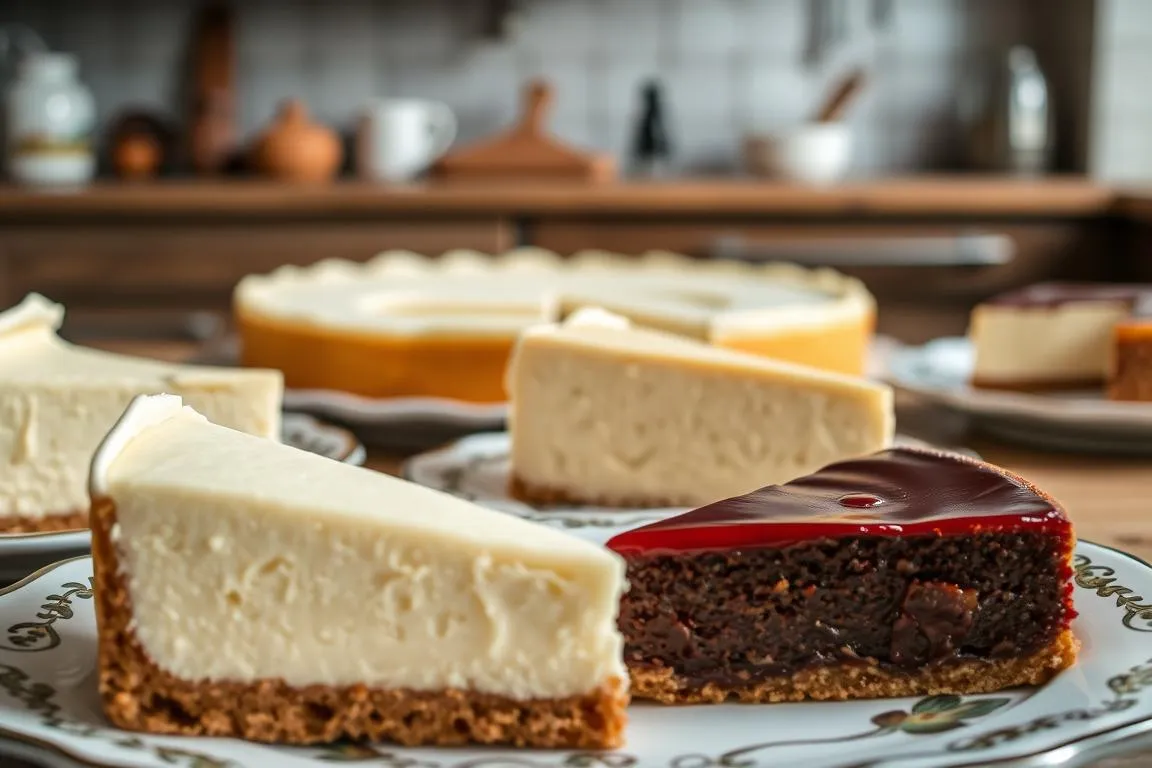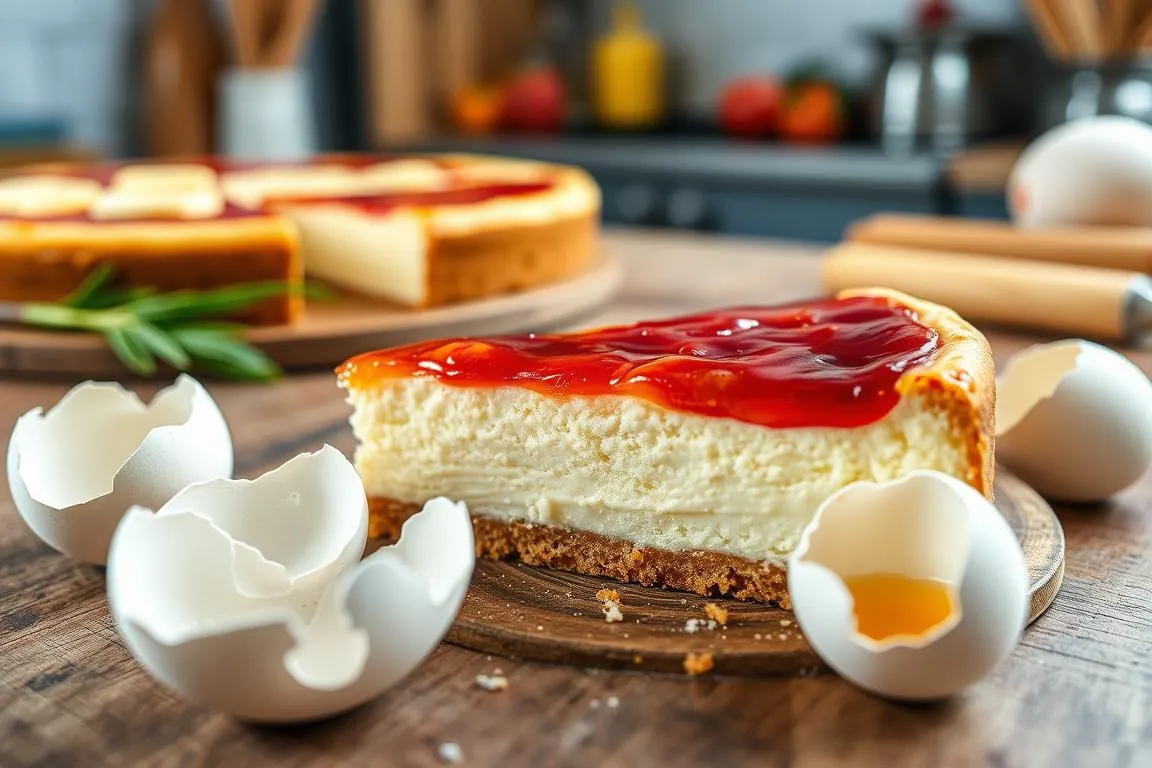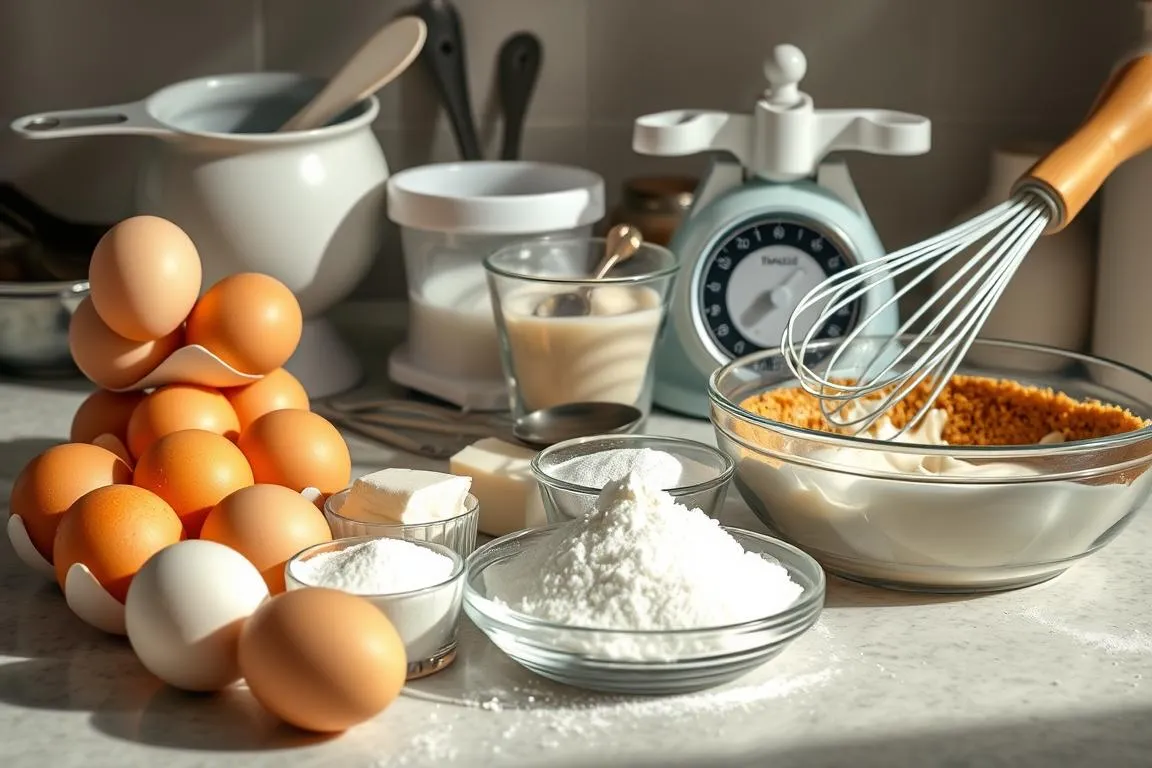What does adding an extra egg to cheesecake do .Making the perfect cheesecake needs careful attention and knowing how ingredients work together. Adding an extra egg can change your cheesecake’s texture and structure in unexpected ways. Professional bakers know that even small changes can make a big difference in a classic dessert.
The world of cheesecake texture is complex and detailed. When you add an extra egg to your recipe, you’re not just adding volume. You’re changing the dessert’s chemical makeup. Knowing these small changes can make your cheesecake go from good to amazing.
Culinary science shows that eggs are key to a cheesecake’s smoothness and richness. Each egg adds unique qualities that affect moisture, protein structure, and how it feels in your mouth.
Key Takeaways
- Extra eggs can significantly alter cheesecake texture
- Chemical reactions during baking impact dessert structure
- Precise egg ratios determine final product quality
- Understanding ingredient interactions is key for baking success
- Professional techniques can improve home baking results
Understanding the Role of Eggs in Cheesecake Baking
Eggs are key to making the perfect cheesecake. They mix texture, structure, and flavor in a special way.
Eggs have special chemical properties. When mixed with cream cheese, they change in amazing ways during baking.
Chemical Reactions During Baking
Protein structure in baking is complex. It shapes the cheesecake’s texture. Eggs help with several important reactions:
- Protein denaturation and coagulation
- Binding of ingredients
- Emulsification of fats and liquids
Protein Structure Formation
Egg proteins make cheesecake smooth and creamy. Heat makes them unfold and connect, creating a stable structure. This structure holds moisture and gives a rich feel.
| Egg Component | Function in Cheesecake |
|---|---|
| Egg Whites | Provide structure and stability |
| Egg Yolks | Add richness and smooth texture |
Moisture Content Control
Eggs control moisture in cheesecake. They keep it creamy and prevent it from drying out.
Understanding the science behind eggs transforms baking from a simple recipe to a culinary art form.
What does adding an extra egg to cheesecake do?
Adding an extra egg to cheesecake changes it a lot. It’s not just a small tweak. It affects the texture, structure, and taste.
- Enhanced structural stability
- Increased moisture retention
- Smoother, creamier texture
- Potential density improvements
Bakers looking for a richer cheesecake often add more eggs. The extra eggs help the cake stay together better. This means less cracking and a more even texture.
“An extra egg can be the secret weapon in creating a restaurant-quality cheesecake at home.” – Professional Pastry Chef
Knowing how eggs affect your cheesecake is important. Not all cheesecakes react the same to egg changes. Things like the type of cream cheese, baking temperature, and how you mix it all matter.
Adding extra eggs can bring benefits like:
- Improved custard-like smoothness
- Better moisture preservation
- Enhanced protein network development
- More forgiving baking process
By trying different amounts of eggs, home bakers can make their cheesecake just right. They can create a dessert that’s exactly how they like it.
The Science Behind Egg-to-Cream Cheese Ratios
Baking the perfect cheesecake is all about the right mix of ingredients. The egg-to-cream cheese ratio is key to the cheesecake’s texture and structure.
Professional bakers know that the exact mix of ingredients makes all the difference. The way eggs and cream cheese work together affects the cheesecake’s quality.
Standard Recipe Proportions
Most cheesecake recipes use a set ratio of eggs to cream cheese. This ratio is chosen to ensure the cheesecake turns out right. Here’s what’s recommended:
- 1 large egg per 8 ounces of cream cheese
- 2-3 eggs for a standard 9-inch cheesecake
- Minimal variation to maintain structural integrity
Modified Ratios for Different Textures
Changing the egg amount can change the cheesecake’s texture. Small changes in the egg-to-cream cheese ratio can make a big difference.
- More eggs make the cheesecake denser and richer
- Fewer eggs make it lighter and fluffier
- Getting the measurements right is essential for success
Impact on Overall Structure
“In baking, precision is an art form, and eggs are the paintbrush that sculpts your cheesecake’s character.” – Professional Pastry Chef
Eggs do more than add flavor. They help the cheesecake stay moist and give it a smooth texture.
Knowing how these ingredients work together lets home bakers try new things. They can make cheesecakes that rival those from professionals.
Texture Changes When Adding Extra Eggs
Understanding how extra eggs change cheesecake texture is key. Adding an extra egg changes your cheesecake’s texture and structure. This is a big deal for your dessert.
Extra eggs make your cheesecake smoother and more even. They also help prevent cracks. This makes your cheesecake feel better in your mouth.
- Increased moisture from extra eggs
- Enhanced protein structure
- Improved binding of ingredients
Comparing creamy to firm cheesecake, eggs are important. An extra egg can make your cheesecake denser. It becomes more like a New York-style cheesecake.
*The magic of eggs lies in their ability to transform simple ingredients into a culinary masterpiece.*
Egg Impact on Cheesecake Texture
| Egg Quantity | Texture Characteristics | Mouthfeel |
|---|---|---|
| Standard Recipe | Light, slightly airy | Soft and delicate |
| Extra Egg Added | Dense, smooth | Rich and creamy |
Professional bakers know eggs are more than just volume. They’re about creating the perfect texture. Adding an extra egg can make your cheesecake amazing.
How Extra Eggs Affect Cheesecake Density
Baking the perfect cheesecake is all about finding the right mix of ingredients. Knowing how extra eggs change cheesecake density can make your baking better. It can even make your dessert look like it was made by a pro.
Extra eggs are key to the cheesecake’s texture and structure. They add more protein and fat. This makes the cheesecake denser and gives it a better crumb.
Firmness Analysis
Adding extra eggs makes the cheesecake firmer. This is because the extra protein creates a stronger network. This network makes the cheesecake denser and more solid.
- Standard recipes usually have 2-3 eggs
- More eggs mean more protein
- More protein makes the cheesecake firmer
Crumb Structure Variations
Adding more eggs changes the cheesecake’s crumb. The extra eggs make the inside more solid and less crumbly. This gives the cheesecake a smoother feel in your mouth.
| Egg Quantity | Crumb Density | Texture Characteristics |
|---|---|---|
| 2 Eggs | Light | Soft, slightly loose |
| 3 Eggs | Medium | Balanced, smooth |
| 4 Eggs | Dense | Firm, compact |
Mouthfeel Differences
The number of eggs really changes how the cheesecake feels in your mouth. More eggs make the cheesecake thicker and creamier. It melts nicely in your mouth.
“Mastering egg ratios is the secret to creating a professional-quality cheesecake.” – Pastry Chef Recommendation
Trying different amounts of eggs lets bakers make cheesecakes that fit their taste. It’s a great way to experiment and find your favorite.
Flavor Impact of Additional Eggs
Adding extra eggs to your cheesecake changes its flavor in small but big ways. The cheesecake’s taste gets deeper and more complex. This is different from what you get in traditional recipes.
Eggs make the cheesecake richer and smoother. They add subtle flavors that make the dessert better. Professional bakers know eggs are key for both texture and taste.
“An extra egg can turn a good cheesecake into an extraordinary culinary experience.” – Pastry Chef Sarah Johnson
- More eggs make the cheesecake taste like custard
- They add layers of flavor
- Make the cheesecake feel richer in your mouth
Egg yolks add fat and lecithin. These help make the cheesecake taste better and feel more luxurious.
| Egg Quantity | Flavor Intensity | Texture Impact |
|---|---|---|
| Standard Recipe | Mild | Light |
| Extra Egg Added | Rich | Creamy |
Pro tip: When adding extra eggs, consider reducing liquid ingredients slightly to maintain the ideal balance of flavor and texture.
Common Problems When Using Extra Eggs
Baking the perfect cheesecake needs precision and knowing common problems. Using extra eggs can lead to specific issues that affect the dessert’s quality.
When adding extra eggs, it’s important to troubleshoot. The right balance of ingredients is key to avoid unexpected results.
Preventing Cracks and Splits
To prevent cracks, you need a strategic plan. Extra eggs can make the cheesecake more prone to imperfections. But, there are ways to overcome this:
- Avoid overmixing the batter
- Use room temperature ingredients
- Bake in a water bath
- Cool the cheesecake gradually
Managing Overbaking Challenges
Overbaking can turn your cheesecake dry. Watch for these signs to avoid it:
| Overbaking Indicator | Recommended Action |
|---|---|
| Dry, cracked surface | Reduce baking time by 5-10 minutes |
| Firm, non-jiggly center | Lower oven temperature by 25 degrees |
| Grainy texture | Check ingredient temperature and mixing technique |
Essential Troubleshooting Solutions
Expert bakers suggest these tips for a perfect cheesecake:
- Use an instant-read thermometer to check internal temperature
- Implement gentle mixing techniques
- Allow for proper ingredient temperature equilibrium
“The secret to a perfect cheesecake lies in understanding how each ingredient interacts.” – Professional Pastry Chef
Remember, practice and patience are key to mastering the art of cheesecake baking with extra eggs.
Adjusting Other Ingredients to Balance Extra Eggs
Adding an extra egg to your cheesecake recipe means you need to make some changes. You have to adjust the amounts of other ingredients to keep the cheesecake just right. This ensures it has the perfect texture and taste.
“Precision is key when balancing cheesecake ingredients for optimal results.” – Professional Pastry Chef
Here are some important steps to take when adding an extra egg:
- Reduce cream cheese by 2 ounces to prevent excessive density
- Slightly decrease sugar content by 1-2 tablespoons
- Adjust flour or cornstarch to stabilize the mixture
These adjustments help balance out the extra moisture and protein from the extra egg. Careful measurement and thoughtful ingredient balancing are key. They help you get a cheesecake that’s creamy and consistent.
| Ingredient | Original Quantity | Adjusted Quantity |
|---|---|---|
| Cream Cheese | 16 oz | 14 oz |
| Sugar | 1 cup | 3/4 cup |
| Cornstarch | 1 tbsp | 1.5 tbsp |
Try out these amounts to find the cheesecake balance that works best for you. It should match your recipe and taste preferences.
Best Practices for Adding Extra Eggs to Cheesecake
Making the perfect cheesecake needs careful attention and knowing how ingredients work together. Adding an extra egg requires special mixing techniques for a smooth, creamy texture.
Precise Mixing Strategies
Good cheesecake mixing starts with ingredients at room temperature. Cream cheese should be soft but not too warm. This makes mixing the extra eggs easier. Here’s what to do:
- Beat cream cheese until it’s smooth and creamy
- Add eggs one at a time, mixing well after each
- Scrape the bowl sides to mix everything well
- Mix slowly to avoid adding too much air
Temperature Precision
The baking temperature is key for a great cheesecake. The right temperature helps avoid cracks and ensures even cooking.
| Ingredient Temperature | Recommended Setting |
|---|---|
| Cream Cheese | Room temperature (68-70°F) |
| Eggs | Room temperature (68-70°F) |
| Oven | 325°F for water bath method |
Adjusting Baking Time
Adding an extra egg changes the baking time. More moisture and protein mean it might take longer to bake.
Pro tip: Check doneness by gentle wobble in center – it should jiggle slightly when pan is tapped.
- Standard baking time: 45-55 minutes
- With extra egg: 50-60 minutes
- Use digital thermometer (internal temp 150°F)
Remember, patience and precision are essential when trying new cheesecake recipes. Every change needs careful watching and practice.
Conclusion
To make your cheesecakes better, you need to know how ingredients work together. Adding an extra egg does more than just change the recipe. It turns your dessert into a true masterpiece.
Mastering cheesecake baking is about understanding each ingredient’s role. Adding an extra egg can make your cheesecake smoother and more luxurious. This impresses even the pickiest eaters.
Learning advanced baking techniques shows how important it is to experiment and know your stuff. Knowing how eggs mix with cream cheese and sugar lets you make desserts that are not only tasty but also precise. Every cheesecake is a chance to get better and appreciate the art of baking.
Remember, baking is both an art and a science. The skills you learn here will help you in all your future baking. Keep learning, trust your instincts, and enjoy the delicious results of your hard work.
FAQ
How does an extra egg change my cheesecake’s texture?
Adding an extra egg makes your cheesecake denser and creamier. It adds more protein, making the cheesecake firmer. This also increases moisture, giving it a smoother texture.
Will adding an extra egg prevent my cheesecake from cracking?
An extra egg can help prevent cracks by adding more protein. But, it’s not a sure fix. To avoid cracks, use a water bath, don’t overbake, and cool the cheesecake slowly.
Can I add an extra egg to any cheesecake recipe?
You can add an extra egg to most recipes, but adjust other ingredients too. You might need to change flour, sugar, or cream cheese amounts to keep the recipe balanced.
Does an extra egg make the cheesecake taste different?
Yes, an extra egg makes the cheesecake richer and more custard-like. It adds a deeper flavor and makes the dessert more indulgent.
What baking temperature should I use with an extra egg?
Keep the baking temperature at 325°F (163°C). You might need to bake it a bit longer. Check the cheesecake’s center; it should be slightly jiggly but not runny.
How do I know if I’ve added too many eggs?
Too many eggs make the cheesecake dense, rubbery, and eggy. It might also crack. Most recipes work best with 3-4 eggs, depending on other ingredients.
Can I use extra eggs to make a lighter cheesecake?
Extra eggs actually make cheesecake denser, not lighter. For a lighter texture, try separating eggs and whipping the whites before folding them into the batter.
Are there specific types of cheesecake that benefit more from extra eggs?
New York-style and dense cheesecakes benefit most from extra eggs. Lighter cheesecakes might become too heavy with extra eggs.
How do I adjust other ingredients when adding an extra egg?
When adding an extra egg, reduce other liquids slightly or add more cream cheese. This keeps the recipe balanced. Always note your changes.
What’s the best mixing technique when incorporating an extra egg?
Use room temperature ingredients and mix at low speed. Add eggs one at a time, fully incorporating each before adding the next. This creates a smooth batter.



